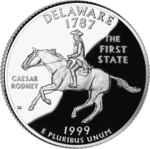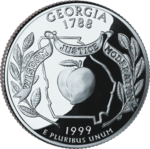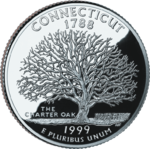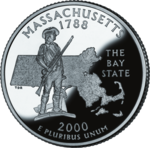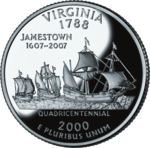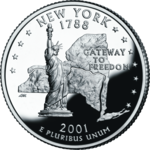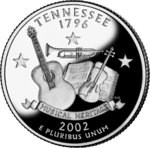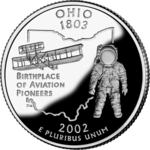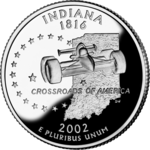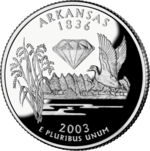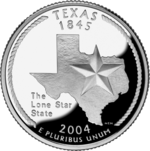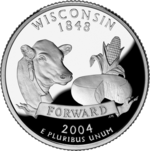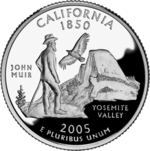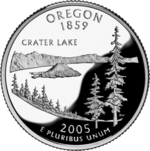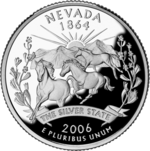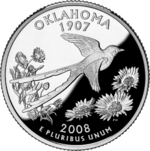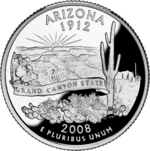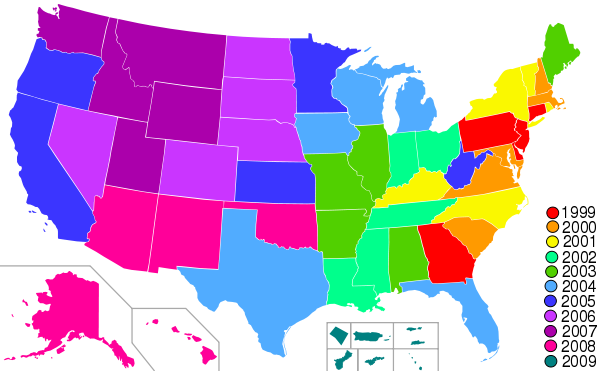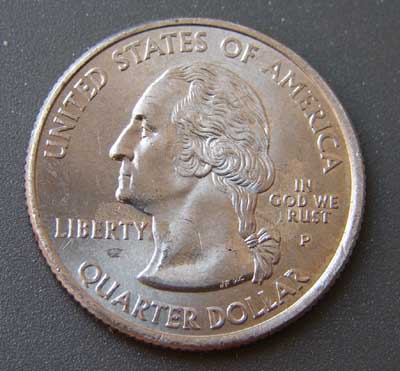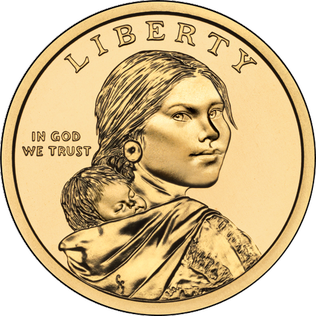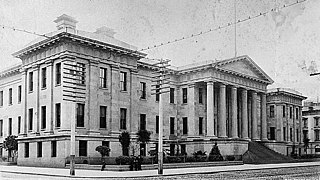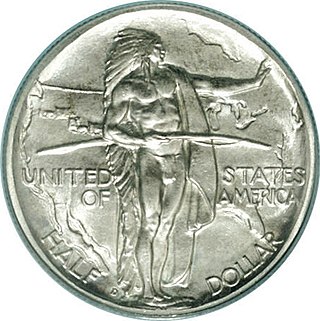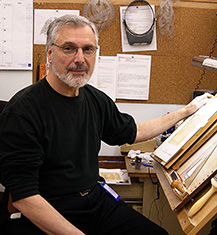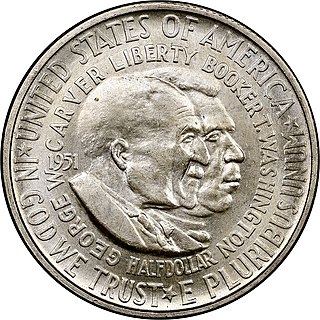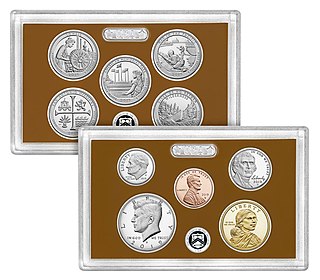It has been requested that the title of this article be changed to 50 State quarters . Please see the relevant discussion on the discussion page. The page should not be moved unless the discussion is closed; summarizing the consensus achieved in support of the move. |
| United states | |
| Value | 0.25 US Dollar |
|---|---|
| Mass | 6.25(Ag); 5.67 (Cu-Ni) g |
| Diameter | 24.26 mm (0.955 in) |
| Thickness | 1.75 mm (0.069 in) |
| Edge | 119 reeds |
| Composition | 91.67% Cu 8.33% Ni (standard) 90% Ag 10% Cu (proof only) |
| Years of minting | 1999–2008 |
| Mint marks | P, D, S (proof only) |
| Obverse | |
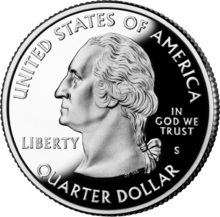 | |
| Design | George Washington |
| Designer | John Flanagan (1932 version) from a 1786 bust by Houdon / William Cousins (modification to Flanagan's design) |
| Design date | 1999 |
| Reverse | |
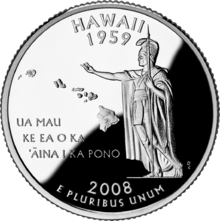 | |
| Design | various; five designs per year |
| Designer | various |
| Design date | 2008 |
The 50 State Quarters Program (Pub.L. 105–124 , 111 Stat. 2534 , enacted December 1, 1997) was the release of a series of circulating commemorative coins by the United States Mint. From 1999 through 2008, it featured unique designs for each of the 50 US states on the reverse of the quarter.
An Act of Congress is a statute enacted by the United States Congress. It can either be a Public Law, relating to the general public, or a Private Law, relating to specific institutions or individuals.

The United States Statutes at Large, commonly referred to as the Statutes at Large and abbreviated Stat., are an official record of Acts of Congress and concurrent resolutions passed by the United States Congress. Each act and resolution of Congress is originally published as a slip law, which is classified as either public law or private law (Pvt.L.), and designated and numbered accordingly. At the end of a Congressional session, the statutes enacted during that session are compiled into bound books, known as "session law" publications. The session law publication for U.S. Federal statutes is called the United States Statutes at Large. In that publication, the public laws and private laws are numbered and organized in chronological order. U.S. Federal statutes are published in a three-part process, consisting of slip laws, session laws, and codification.

The United States Mint is a unit of the Department of Treasury responsible for producing coinage for the United States to conduct its trade and commerce, as well as controlling the movement of bullion. It does not produce paper money; that responsibility belongs to the Bureau of Engraving and Printing. The Mint was created in Philadelphia in 1792, and soon joined by other centers, whose coins were identified by their own mint marks. There are currently four active coin-producing mints: Philadelphia, Denver, San Francisco, and West Point.
Contents
- Treasury opposition and congressional enactment
- State Quarters Program
- Designs
- District of Columbia and United States Territories release
- Additional notes on individual designs
- Year map
- Collectible value
- Seigniorage
- Satire
- See also
- References
- Bibliography
- External links
The 50 State Quarters Program was started to support a new generation of coin collectors, [1] [2] and it became the most successful numismatic program in history, with roughly half of the US population collecting the coins, either in a casual manner or as a serious pursuit. [3] The US federal government so far has made additional profits of $3.0 billion from collectors taking the coins out of circulation. [4]
Numismatics is the study or collection of currency, including coins, tokens, paper money and related objects. While numismatists are often characterised as students or collectors of coins, the discipline also includes the broader study of money and other payment media used to resolve debts and the exchange of goods. Early money used by people is referred to as "Odd and Curious", but the use of other goods in barter exchange is excluded, even where used as a circulating currency. The Kyrgyz people used horses as the principal currency unit and gave small change in lambskins; the lambskins may be suitable for numismatic study, but the horses are not. Many objects have been used for centuries, such as cowry shells, precious metals, cocoa beans, large stones and gems.
Seigniorage, also spelled seignorage or seigneurage, is the difference between the value of money and the cost to produce and distribute it. The term can be applied in two ways:
In 2009, the US Mint began issuing quarters under the 2009 District of Columbia and US Territories Program. The Territories Quarter Program was authorized by the passage of a newer legislative act, H.R. 2764. This program features the District of Columbia, Puerto Rico, American Samoa, Guam, the United States Virgin Islands, and the Northern Mariana Islands. [5]

The District of Columbia and United States Territories Quarter Program was a one-year coin program of the United States Mint that saw quarters being minted in 2009 to honor the District of Columbia and the unincorporated United States insular areas of Puerto Rico, Guam, United States Virgin Islands, American Samoa, and the Northern Mariana Islands. The islands commonly grouped together as the United States Minor Outlying Islands were not featured, as the law defined the word "territory" as being limited to the areas mentioned above. It followed the completion of the 50 State Quarters program. The coins used the same George Washington obverse as with the quarters of the previous 10 years. The reverse of the quarters featured a design selected by the Mint depicting of the federal district and each territory. Unlike on the 50 State quarters, the motto "E Pluribus Unum" preceded and was the same size as the mint date on the reverse.

Puerto Rico, officially the Commonwealth of Puerto Rico and briefly called Porto Rico, is an unincorporated territory of the United States located in the northeast Caribbean Sea, approximately 1,000 miles (1,600 km) southeast of Miami, Florida.

American Samoa is an unincorporated territory of the United States located in the South Pacific Ocean, southeast of Samoa. Its location is centered on 14.2710° S, 170.1322° W. It is on the eastern border of the International Date Line, while independent Samoa is west of it.


